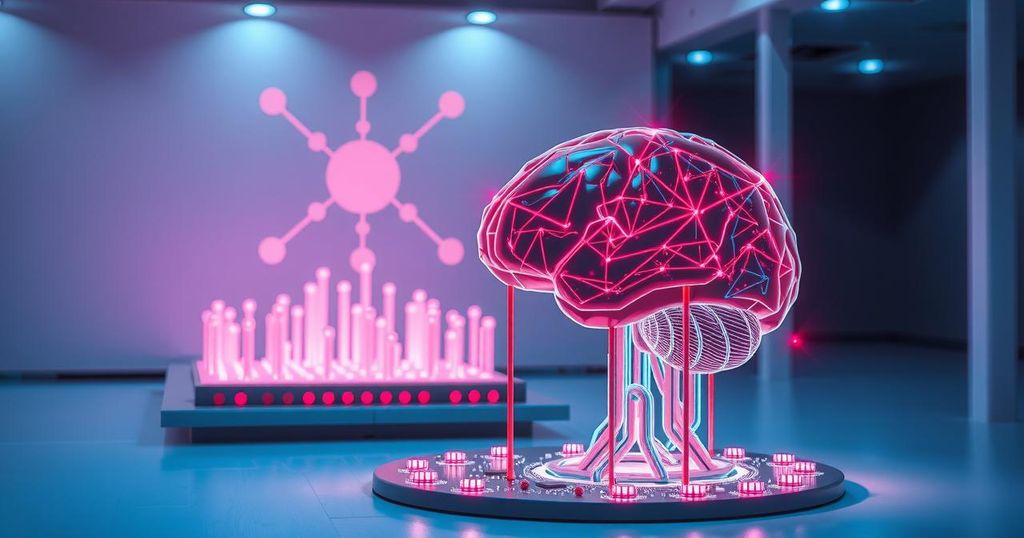The Rise of AIoE: Transforming Connectivity and Intelligence
The Internet of Everything (IoE) facilitates connectivity among devices, people, and systems. AIoE enhances this by integrating autonomous intelligence, allowing for self-learning systems to analyze and act on data. This shift significantly increases data utilization, operational efficiency, and decision-making capabilities across various sectors, particularly in government and business.
The concept of the Internet of Everything (IoE) revolves around connectivity, enabling seamless communication among devices, people, and systems. It forms the essential infrastructure that binds various elements, creating a more interconnected world. In contrast, the Artificial Intelligence of Everything (AIoE) enhances IoE by infusing autonomous intelligence into these networks, allowing for self-learning systems that analyze and react to collected data, which deeply transforms decision-making processes and streamlines automation.
Key technologies underpinning IoE include sensors, connectivity via IoT networks, cloud computing, and machine-to-machine communication, which facilitate data sharing among devices. AIoE builds upon these elements by integrating AI technologies such as machine learning, natural language processing, and computer vision, thereby equipping systems with the ability to learn and adapt autonomously while making complex decisions in real-time.
Use cases of IoE exemplify its role in smart cities, industrial IoT, and healthcare. By linking systems like traffic management and public transport, IoE optimizes resource utilization. In a further leap, AIoE not only connects these systems but also infuses them with intelligence, allowing things like traffic systems to predict and manage congestion while healthcare solutions autonomously detect anomalies and foresee patient outcomes.
While IoE reformulates collaboration between people and processes, focused on user input, AIoE advances this by enabling automation where AI systems can make decisions independently or offer actionable insights. This shift fosters greater autonomy, empowering processes with proactive, AI-driven analysis rather than limited preset rules.
Data utilization transforms significantly from IoE to AIoE; IoE mainly emphasizes data gathering for insights, whereas AIoE prioritizes thorough analysis and real-time decision-making. AIoE’s strength lies in its capability to generate predictive analytics and automate responses, minimizing human intervention and successful operational outcomes.
Both IoE and AIoE contribute significantly to societal and business efficiencies. IoE enhances connectivity for smoother operations and faster responsiveness, while AIoE fosters intelligent systems that perceive needs, manage complexities, and compel innovation. This transformation turns IoE into a self-optimizing network, functioning capably with minimal human oversight.
Real-world examples showcase IoE applications like smart home devices and connected vehicles, while AIoE introduces advanced capabilities like self-learning environments and AI-managed supply chains, revolutionizing industries and operations alike. The shift towards AIoE reflects a critical evolution, particularly for government operations, changing data interaction from simple aggregation to meaningful, actionable insights.
The immense potential of AIoE lies within governmental operations, where it can significantly cut costs and streamline repetitive tasks like data processing. By reducing human involvement, resources can be better allocated, particularly in urgent sectors such as healthcare or education, reaffirming AIoE’s ability to enhance efficiency across all levels.
In summary, the transition from IoE to AIoE presents substantive benefits by allowing systems to automate, predict, and optimize with limited human input, ensuring that governments can adapt swiftly to the complexities of contemporary society while improving security, public service delivery, and informed policymaking.
The evolution from the Internet of Everything to the Artificial Intelligence of Everything signifies a fundamental transformation in connectivity and intelligence within technological systems. IoE connects devices and promotes communication and data sharing, while AIoE introduces advanced AI capabilities, enabling autonomous decision-making and proactive system operations. This major shift indicates a move towards a smarter, more responsive approach to managing technological networks that impact various sectors, including business and government.
AIoE heralds a new era in which systems are not only connected but also imbued with intelligence, leading to optimized operations and innovative solutions. The integration of AI into connected systems is pivotal for industries and governments to enhance efficiency, rapidly adapt to changes, and improve service delivery. The journey from IoE to AIoE is a testament to the ongoing quest for smarter, more automated systems that enrich our lives and streamline processes.
Original Source: statetechmagazine.com




Post Comment